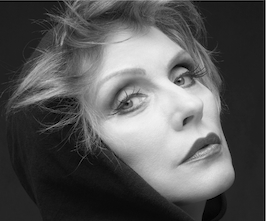
An inter-media transfer is in place that celebrity-chasing reporters have been eagerly awaiting.
Movie star Katie Holmes (movie star, and still newly-divorced wife of a movie mega-star, of course) takes to the boards of a Broadway live-action theater. The play is Dead Accounts, by Theresa Rebeck, opening officially tonight (Thursday, Nov. 29).
It's true that Holmes has worked in this reputedly humbler medium before. And to be fair, it was on Broadway then, too (in Arthur Miller's All My Sons) so "humble" isn't the ideal identifier here. But her media stock-price valuation has never ridden as high as in the four months since she left her marriage to Tom Cruise and filled the tabloids' front pages, along with her astonishingly photogenic six-year old daughter Suri.
Riding the media-management tiger through her divorce case has been skillful accomplishment enough, and her new task of establishing herself afresh as simply a working (and multimedia) actress, quite regardless of that private life that obsesses the media, has inevitably proved to be a big challenge too.
Some sense of the tensions involved has shown up, for instance, in an interview with The New York Times' arts pages which she at first declined (on the grounds, we'll understand, that the paper's interest was solely focused on her as Katie Holmes and the ex-Mrs. Cruise, and not on "the work" or "the art"). She then agreed to participate only when her fellow cast-member Norbert Leo Butz was added to the interview mix -- and the article's focus became more clearly the theatrical production that she wanted to promote.
In that interview, helpfully, Butz commanded a palpably stronger place -- with more assertive and insightful explications of the play -- just as he completely dominates the production itself with his (previously twice Tony-winning) powerful verve and pathos. Holmes, for the record, turns in a steady workaday performance. Perhaps too steady, since she comes off as an oddly one-note character, even though Rebeck's script, as in many a domestic comedy, calls for sharp and sudden mood-changes.

Photo by Joan Marcus © Broadway.com
But an underlying mechanism working throughout the piece -- like it or not (and whether Holmes herself likes it or not) -- lies in the sheer presence of this constantly-limelighted celebrity on a stage-set that represents a pretty dreary middle-class kitchen in Cincinnati. The effect is heightened by the play's continual contrasting of big-time glitzy "values" -- in this case the mega-millions of New York's Upper East Side, not the mega-millions of Hollywood - against the homespun simplicity of ethics that allegedly permeates the Midwest. (In real life Holmes does hail from Ohio, just two hundred miles north of Cincinnati.)
As so often in Broadway plays these days, as they spice their marquees with big-name movie stars (and in whose absence it's doubtful investors would ever have been attracted, or the production ever been mounted) the audience reveals exactly what's going on. And we didn't have to wait long. At the preview I attended it took just four seconds from the stage lights first going up before applause broke out -- for Katie Holmes and her co-star sitting at a table. Applause not for working successfully at entertaining us, of course, but for... well, for being recognized.
That uncomfortable conundrum appears in another medium this week, even one where the imperative is even more strongly to convey "the work" and "the art," and not concern itself with vulgar matters like celebrity.
It crops up in a still relatively young magazine that rejoices in the name Lid, a high-art magazine devoted to the medium of photography. It's one of those esthete's delights of a publication that will appear with five different cover pictures for a given issue. (Lower down the highbrowness scale, Vanity Fair occasionally will sometimes pretentiously fanfare its own such variation-on-a-theme contrivances.)
Part of Lid's appeal is its very recherché nature. Its contents do not appear online -- although its covers do. And to get your hands on a complete hard-copy edition you have a choice of fewer than 20 outlets. Most of them are in Manhattan (but look for hip clothing stores and hotels rather than boring old newsstands) and there are a few others in Paris, Berlin, Tokyo, and Stockholm.
The current issue -- "Number 15," out yesterday -- carries a remarkable portfolio of images, reproduced in exquisite quality, from Joe Gaffney, an artist who these days works in oils and collages of paper, but who enjoys a deservedly gigantic reputation for photographic work from Paris in the 1970s and 1980s. And while he devoted himself almost full-time to painting after quitting Paris for his current base New York, he has more recently returned to photography in addition to his painting -- nowadays exploiting digital techniques in fresh and challenging ways.
His twenty pages in Lid present with extraordinary sharpness portraits from those earlier days in Paris, and also in London. The faces looking out at us definitively evoke an effervescent, even febrile era.
But here's the thing. They are all famous faces. Celebrities, it has to be said (or at least that label seems de rigueur these days). In a remarkable tribute to Gaffney's star-pulling power, the subjects include Salvador Dali, Dennis Hopper, Marianne Faithful, Ann-Margret, Cecil Beaton, Keith Moon, Brian Eno, Zandra Rhodes, Peter Brook and -- in the last portrait for which he ever sat -- Man Ray.
So the gnawing thought cannot be shaken off: would we be looking at these portraits if they weren't of well-known people, about whom we think we know something? ... And if there wasn't, when we stare at their features on the page, the inevitable intricate interaction between what we see in the picture and the preconceptions about its famous subject that we bring with us?

And yet at the same time the pictures can stand just as sudden jolts to the eye and to our aesthetic sense, regardless of the famous name they might carry. An example I'd single out is Debbie Harry. Perhaps significantly it's a picture from more recently (2007) rather than one of the many pictures Gaffney made of her from 1974 to 1984. It's unfair to reproduce it here on my site (above right) but it's one of the covers you can see in full resolution at Lid's site) It is a stunning rendering of completeness in a face -- even when it's in essence simply an assured woman in a headscarf, freeze-framed in a full beam of light.
Gaffney himself told me that for him the star-power of his subjects has never interfered with his portraiture; he sees them determinedly as the unadulterated human beings they must be at heart and in reality. "I've photographed many non-famous people and have managed to find 'that thing'." By 'that thing' Gaffney means the truthful face that a subject, well-accustomed to being photographed or not, eventually offers the camera when they have exhausted all their various 'fronts'.
Art, when rigorously worked at, can indeed deliver such truth -- regardless of how the publicist's craft may complicate the process.
And with art in the medium of the theater... I should also admit that there are moments, precious moments, in Dead Accounts -- when the glamorous, much-discussed and paparazzi-hounded Katie Holmes becomes simply a pony-tailed young woman scared for her beloved brother as he skitters between opposing moral universes. Art can win out against our celebrity-culture.
* * * *
Read more of David Tereshchuk's media industry insights at his weekly column, The Media Beat, with accompanying video and audio. Listen also to The Media Beat podcasts on demand from Connecticut's NPR station WHDD, and at iTunes.